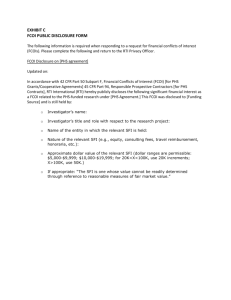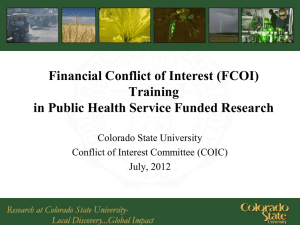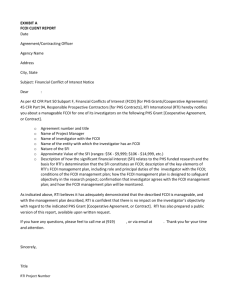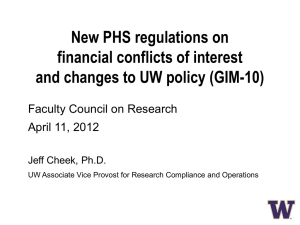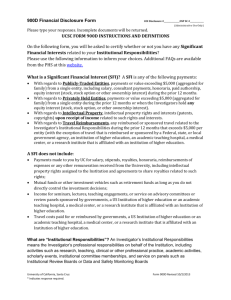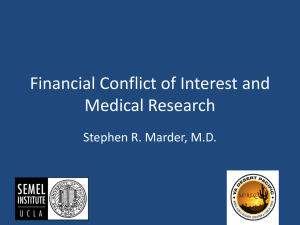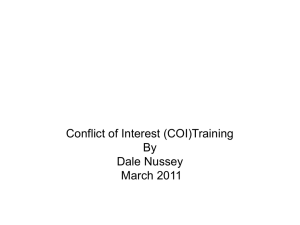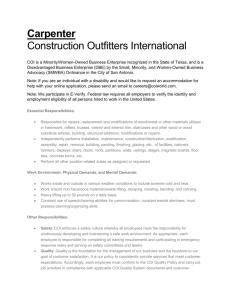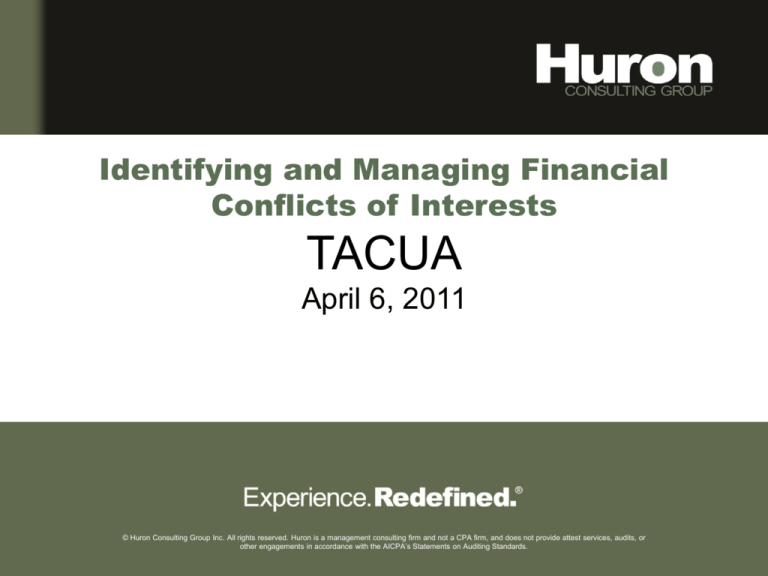
Identifying and Managing Financial
Conflicts of Interests
TACUA
April 6, 2011
1
© Huron Consulting Group Inc. All rights reserved. Huron is a management consulting firm and not a CPA firm, and does not provide attest services, audits, or
other engagements in accordance with the AICPA’s Statements on Auditing Standards.
Today’s Guests
Stuart Horowitz, PhD MBA
Life Sciences & Advisory Services
•
•
•
•
>20 years of experience
Scientist, investigator
Research administrator
Assists with research strategy, compliance, operations,
finances
• Focus on ethical research, COI management
2
Agenda
• Introduction/Background
• Recent Headlines
• Definitions (current)
• Approaches to Identifying and Managing COI
• Proposed Regulations
• Implications for the Future
3
COI – Ethics and Compliance
• Rules & Regulations
• Guidelines
• Processes
• Few Bright Lines
• “NY Times Test”
• Good Sense
• Ethics
From: The Ethicist, NY Times
4
Background and Recent Headlines
When do More >1 Interests Conflict?
• A conflict of interests (COI) can arise when a person is
faced with a decision that might be influenced by two
competing interests.
• (Although the term “conflict of interest” is often used,
there is only a conflict by virtue of the existence of more
than one interest—hence the plural form.)
• We may digress to the singular form, which most people
use anyhow.
6
COI issues are ubiquitous
• Not only Research, Education, & Healthcare
• Politics
• Law
• Purchase & Acquisition
• Employment
• Family
• Everyday Life
7
COI in The News NY Times April 3, 2011
Tipping the Odds for a Maker of Heart Implants
COI in The News NY Times April 3, 2011
• $5,000/mo
• Consulting fees
• Steering
trials/registries
• “Loser List”
“Our #1 Implanting Hospital“
UMC… never pressed the
physician about his possible
ties to Biotronik, nor did he
disclose any…
Conflict of Interest Definitions
Many situational factors characterize
any potential conflict of interests
• Primary vs. secondary interests
• Institutional or individual
conflicts
• Real vs. perceived conflicts
A conflict of interests exists when a
secondary interest conflicts with a
primary interest
Primary Interest
“Do what is right”
POSSIBLE CONFLICT
Secondary Interest
“Personal Financial Gain”
NOTE: A conflict of interests is NOT a statement of wrongdoing.
12
Secondary interests conflict with primary
interests in a number of circumstances
• Primary interest: Train students by having them work on projects
• Secondary interest: Use graduate students as free labor on startup
• Primary interest: Spend time working on class lectures
• Secondary interest: Spend time marketing patent for licensing
• Primary interest: Order best equipment for lab
• Secondary interest: Order equipment from a company that adds
research funding and pays for travel to meetings
13
A Potential for COI Exists if an Individual…
• Receives research support from, or evaluates products or
procedures of a business in which he or she or a family
member has an ownership interest (stock/options/deferred
compensation)
• Receives payments (consulting fees/honoraria/other) from
an outside entity
• Uses institution’s resources for an outside entity, provides
current or future rights to an entity for institution’s IP
14
A Potential for COI Exists if an Individual…
• Accepts compensation for serving on an advisory or
governing board
• Can influence institution’s business decisions with an entity
he or she has an ownership interest in
• Agrees to limits on publication, peer-review of research
• Agrees to favorable research results
• Conducts research with an invention (any IP) involving
possible future royalties or other cash flows
• Supervises a member of his or her immediate family
15
Non-Financial Conflicts of Interest may also
interfere with researchers’ decision-making
• Career Advancement
• Personal Advancement
• Favoritism – Family and Other
• Scientific Bias
• Glory – PR
Not easily identifiable or manageable
16
Conflict of Interests Defined
• A situation in which financial or other considerations have
the potential to compromise or bias professional judgment
and objectivity.
• At least 2 interests are conflicted (e.g. objectivity vs. $$$).
• Involves the use of authority for financial or other gain.
• May involve both individuals and institutions.
• Planning, conduct, reporting of research.
• Not a statement of wrongdoing.
17
COI ≠ Wrongdoing
• “Conflicts of interest are ubiquitous and
inevitable in academic life, indeed, in all
professional life. The challenge for academic
medicine is not to eradicate them, which is
fanciful and would be inimical to public policy
goals, but to recognize and manage them
sensibly and effectively.”
•
David Korn JAMA 284, 2234-2236, 2000
Either individual or institutional
interests may create potential conflicts
• Individual
– Investigators
– Students
– Research technicians, data analysts
– IRB members
– Anyone involved in technology transfer
– Anyone involved in procurement, education, healthcare
• Institutional
– Financial & IP holdings of the institution
– Allocation of resources for research
– Executives and board members
19
When addressing real or perceived
conflicts of interests…
20
…Perception is Reality
Conflicts of Interests introduce a number
of added risks to any research endeavor
• Human Subject Protection
• Research Integrity
• Individual Integrity
• Public Trust in Institution
• Research Participation
• Public Trust in Research
• Progress in Biomedical Research
• Funding and Reimbursement
21
Regulations and Guidance
What are The Rules?
Overview
Industry Landscape
• ↑ Complexity of relationships with industry
• ↑ Budget federal $$
• ↑ Industry research $$$
• Growth of translational strategies
• Growth of multidisciplinary science centers
Goals of Proposed Rule Changes
• Expand and add transparency to disclosure of Significant
Financial Interests
• Clarify and define terms in PHS regulations
We await final rules
24
Need to Know – Proposed Definitions*
New Definitions
• PD/PI
• Disclosure of Significant
Financial Interests
• FCOI Report
• Financial Conflict of
Interest
• Financial Interest
• Institutional
Responsibilities
• Manage vs. Mitigate
25
•
•
•
•
•
•
•
Revised Definitions
Contractor
Investigator
Institution
PHS
Research
Significant Financial
Interest
Monetary Threshold
*Revised definitions and or concepts
Minor Revisions of Old Definitions
Contractor
• Now applies to an entity that provides property or services ‘‘under
contract’’ for the direct benefit or use of the Federal Government.
Institution
• Refers specifically to an Institution that is applying for, or that receives,
PHS research funding.
Investigator
• Any other person, regardless of title or position, who is responsible for;
• The design, conduct, or reporting of research funded by the PHS, or
• Proposed for such funding, including persons who are sub-grantees,
contractors, collaborators, or consultants.
26
ACTION!
Check your policies for who is
required to disclose and adjust
accordingly
27
Minor Revisions on Old Definitions
Minor Revisions
of
Old
Definitions
(Continued)
• PHS Grant – This definition now includes a specific reference
to the National Institutes of Health.
• Research – Now includes a non-exclusive list of examples of
different types of PHS funding mechanisms such as
– Grants
– Cooperative agreement
– Career Development Award
– Center Grant or Individual Fellowship award
– Any activity where funding is available from PHS
– Our expectation is that NSF and public expectations will
follow PHS policy
– Institutions should not have double standards on FCOI
28
ACTION!
Check your policies for which
activities are covered and adjust
accordingly
29
Minor Revisions of Old Definitions
• Disclosure of FIs happens from Investigator to Institution (+/Committee).
– Institution that is applying for or receives PHS funds.
• Disclose FIs that reasonably appear to be related to the
Investigator’s institutional responsibilities.
– FI = Anything of monetary value (current or potential).
• Significant relates to the amount and to a possible
relationship to the investigator’s institutional responsibilities.
– Who determines what reasonably appears to be related? (Not the
investigator/discloser/respondent)
• The institution determines relatedness.
30
ACTION!
Disclose all FI except for what is
obviously unrelated to institutional
responsibilities
31
Problems with Old and New Definitions
• Refers to “significant”
32
ACTION!
When requesting disclosures avoid
the terms “significant” and “conflict”
Use the term “disclosed FI” versus
“SFI”
33
Substantial Revisions - SFI Monetary
Thresholds
• At least 1 of the following interests is a SFI:
– If a publicly-traded company, if the
value of past 12 mos remuneration + value of current equity
>$5,000 (on the day of disclosure)
– If a non-publicly-traded company (e.g. startup) if the
value of past year’s remuneration >$5,000 OR…
If the investigator holds any equity interest
– Intellectual property rights (e.g., patents, copyrights), royalties from
such rights, and agreements to share in royalties related to such
rights
• Excluded: Work for government entities or an institution of
higher education.
34
ACTION!
Require disclosure of any amount
and recalibrate your thresholds to
analyze disclosed FI
35
Disclosure vs. Reporting
Disclosure vs. Reporting
Disclosure
Investigator
36
University
Research Integrity Office
OR
COI Committee
New Definition - FCOI Reports
• Communication from the Institution to PHS regarding
FCOI, initially, prior to the Institution’s expenditure of
any funds, and ongoing.
• If your standards are higher (stricter) than PHS’s,
reports to PHS are held to your standards.
• Must include a description of the key elements of
management plans that were put in place.
• Additional requirements for reports based on timeliness
of disclosures and reviews.
37
ACTION!
Watch for new structured report
requirements
38
New Definitions – Project Director /
Principal Investigator
• The PD/PI is the Project Director and/or the Principal
Investigator of a PHS-funded research project.
– This term will be used in the new regulations in circumstances
where the term “Principal Investigator” may have been used in the
past.
“PD/PI”
Investigator X
39
Director Y
New Definitions - Institutional
Responsibilities
• A clear and deliberate move away from disclosure of SFIs
on a project-specific basis. (Yet reporting will be project
specific)
• Hope to gain a better understanding of the totality of an
Investigator’s interests …result in more consistent
identification, evaluation, and management of COI.
• Investigator’s professional responsibilities on behalf of the
Institution including, but not limited to activities such as
40
– Research
– Research consultation
– Teaching
– Professional practice
– Institutional committee memberships
– Service on panels such as Institutional Review Boards or Data and
Safety Monitoring Boards.
ACTION!
Educate your faculty & staff on this
shift
41
New Definitions - Manage
• Manage means to take action to address a financial
conflict of interest, which includes reducing or eliminating
the financial conflict of interest, to ensure that the design,
conduct, or reporting of research is free from bias or the
appearance of bias.
• Includes management of any financial conflicts of a subrecipient Investigator.
• Require that, prior to the Institution’s expenditure of any
funds …Institution shall …[if an FCOI exists] …develop
and implement a management plan that shall specify the
actions that have been, and shall be, taken to manage
such FCOI.
42
ACTION!
Make sure a formal management plan
is part of your process for FCOIs
43
When is FI = FCOI?
• Financial Conflict Of Interests = a significant financial
interest that could directly and significantly affect the
design, conduct, or reporting of PHS-funded research.
• Could implies potential and to some extent appearance.
Could is in the eye of the beholder.
• Affect refers to bias or the potential for bias. The potential
for bias is a matter of opinion.
• The review process determines which disclosed FIs are
COIs.
44
ACTION!
If there is an FI and it is related to an
individual’s institutional
responsibilities, then it is more likely
than not to be a FCOI and thus
requires a management plan
45
Updated FCOI Disclosure Requirements
– It’s all about timing
• Investigators will be required to disclose Significant
Financial Interests on an ongoing basis
– This amends the previous mandate of disclosing interests each
time a new project is undertaken
– Remember, financial interests include those associated with
spouses or children of the Investigator in question
• All investigators could
potentially conduct research
at any time
• These investigators could
have current or potential
FCOI’s
46
This could
potentially get
complicated
ACTION!
Develop policies to govern timing and
accountability of FCOI submissions
for each investigator
47
FCOI Disclosure requirements - After
Spending Begins
• If the disclosure is timely (within 30 days of the
identification of the conflict):
– Institution shall, within sixty days: Review the FI
disclosure; determine whether it is related to PHSfunded research; determine whether a FCOI exists;
and, if so, implement, on at least an interim basis, a
management plan that shall specify the actions that
have been, and will be, taken to manage the FCOI.
– Institution may determine that additional interim
measures are necessary with regard to the
Investigator’s participation in the PHS-funded research
project between the date of disclosure and the
completion of the Institution’s review.
ACTION!
Revise your processes for post-hoc,
incidental disclosure etc, to comply
with these new requirements
49
FCOI After Spending Begins (continued)
• (B) implement, on at least an interim basis, a mitigation
plan which shall include review and determination as to
whether any PHS-funded research, or portion thereof,
conducted prior to the identification and management of
the FCOI was biased in the design, conduct, or reporting
of such research.
• Institution may determine that additional interim measures
are necessary with regard to the Investigator’s
participation in the PHS funded research project between
the date that the FI is identified and the completion of the
Institution’s review.
50
ACTION!
Revise your processes for post-hoc,
incidental disclosure etc, to require a
mitigation plan
51
Notable Changes – Transparency of
FCOI Policies
Old Rules
• Not only must Institutions
maintain an up-to-date COI
policy that is enforced in
accordance with PHS
standards, this policy must
be on file and in writing
COI Policy
52
New Rules
• Institutions must make
available a written copy of
their current COI policy on
a publicly accessible
website
COI Policy
ACTION!
Develop or improve a section of your
website to include COI policies that
can be regularly updated
53
Notable Changes – FCOI Policies of
Subcontractors/Sub-grantees
Old Rules
• Institution must take
“reasonable steps” to
ensure that Subcontractors
or Sub-grantees are
compliant within the
regulations
New Rules
• Institution must clearly
state which FCOI policy
(e.g. the Institutions or the
Sub’s) will be used when
Subcontractor/Sub-grantee
activity is present
Regardless of who’s FCOI policy is used, it
must comply with PHS standards!
54
ACTION!
Develop policies and SOPs to
manage the process of determining
whose FCOI will be used
55
Elements of FCOI Reports
•
•
•
•
Project/Contract number
PD/PI or Contact PD/PI if multiple PD/PI model is used
Name of the Investigator with the FCOI
Nature of the financial interest (e.g., equity, consulting fee,
travel reimbursement, honorarium)
• Value of the financial interest (dollar ranges would be
permissible: $0– $4,999; $5,000–$9,999; $10,000– $19,999;
amounts between $20,000– X$100,000 by increments of
$20,000; amounts above $100,000 by increments of
$50,000), or
• A statement that the interest is one whose value cannot be
readily determined through reference to public prices or
other reasonable measures of fair market value
56
Elements of FCOI Reports (Continued)
• A description of how the financial interest relates to the PHSfunded research and the basis for the Institution’s
determination that the financial interest conflicts with such
research
• A description of the key elements of the Institution’s
management plan, including
57
• The role and function of the conflicted Investigator in the
research project; The rationale for including the conflicted
Investigator in the research project; The conditions of the
management plan; How the management plan will safeguard
objectivity in the research project; Confirmation of the
Investigator’s agreement to the management plan; How the
management plan will be monitored to ensure Investigator
compliance; Other information as needed.
ACTION!
Watch for new structured report
requirements
58
Potential FCOI Management Approaches
• Public disclosure of FCOI (e.g., when presenting or
publishing the research).
• For research projects involving human subjects
research, disclosure of FCOI directly to participants.
• Appointment of an independent monitor capable of taking
measures to protect the design, conduct, and reporting of
the research against bias, or the appearance of bias.
• Modification of the research plan.
• Change of personnel or personnel responsibilities, or
disqualification of personnel from participation in all or a
portion of the research.
• Reduction or elimination of a financial interest (e.g., sale
of an equity interest); or severance of relationships that
create actual or potential financial conflicts.
59
ACTION!
Develop a library of management
plans for your institution
60
Additional Nuggets…
• Mandatory investigator education – initially and every two
years.
• Requirement to manage management plans.
• Removal of the exemption for Phase I SBIR/STTR grants.
• Requirement to post your policies and procedures on a
public website.
• Requirement, prior to spending PHS funds, to post a
plethora of information about investigator’s FI on a public
website.
• Keeping the website 60-days current, and
for years.
61
Actions
• Develop a new education
program for your faculty &
staff.
• Make sure your
management plans can be
managed.
• Develop a section of your
web site where required
FCOI data are posted and
kept current.
62
Post Current
FCOI Data
Education
Program
Management
Plans
Compliant FCOI
Management Approach
What Else Should You Do?
1
Read and understand the proposed revisions; they
show what you must do.
2
Conduct a thorough assessment of your readiness
Does what you have in writing = what you
actually do in practice?
3
Identify the gaps between what you do and what you
are required to do.
4
Devise a plan to fill the gaps, including a timetable,
budget and accountability matrix. Consider adopting
e-COI technology.
5
63
Execute the plan for change.
Approaches to Managing COI
How to Deal With COI?
• David Armstrong, The Wall Street Journal:
–HHS requirement… to manage, reduce or eliminate
conflicts
–“How they do so is left largely to them.”
65
How to Deal With COI?
66
Risk
COI Continuum
Permissive
67
Restrictive
Goals of COI Policy
• Protect research participants
• Protect the integrity of the research
• Protect the institution & faculty
– Funding Status
– Litigation
– Reputation/Public Image
• Reconsideration & Noncompliance
• “Good Policy Practices”
68
Elements of COI Policy
• Purpose & Position & Principles
• Definitions, Limits
• Who Must Disclose
• Examples
• Process
• Responsibilities
• Consequences
69
How to Deal With COI?
• Standard Operating Procedures
– Annual Disclosure
– Ongoing/Incidental Disclosure
– Analysis: Standards, Thresholds
– Administrative Processes
– COI Committee
– Management Plans
– Tracking and Monitoring Plans
70
Institutions must ensure that several identification
and disclosure mechanisms are in place
• Formal – Annual & Incidental
• Must be Required
• Define Exemptions
• Project-Specific Disclosures
• Informal Disclosures (Document)
• Disclosure by Hotline
71
COI management plans may include a range of
actions depending on the nature of the conflict
• Manage or Reduce
• Eliminate (Recusal or Divestiture)
• Written
• Acknowledged
• Appeal or Reconsideration
• Shared Inside & Out (NIH)
• Monitored
• Audited
72
Elements of COI Management Plans…
• Disclosure to Participant
• Firewall
73
• Reduced or End of
Payments
• Limits to Activities
• Partial or Complete
Divestiture
• Limits to Role (PI)
• Individual Recusal
• Independent Monitoring
• Complete Recusal
74


